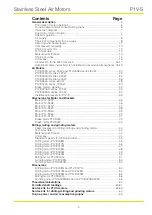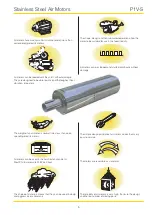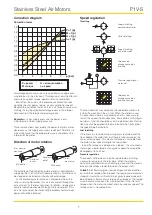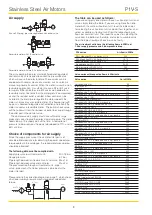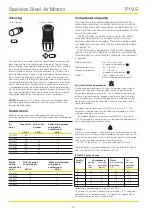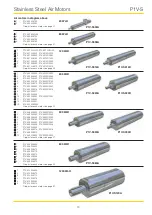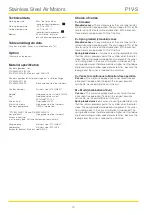
7
Stainless Steel Air Motors
P1V-S
All catalogue data and curves are specified at a supply pres-
sure of 6 bar (in the inlet port). This diagram shows the effect of
pressure on speed, torque, power and air consumption.
Start off on the curve at the pressure used and then look
up to the lines for power, torque, air consumption or speed.
Read off the correction factor on the Y axis for each curve and
multiply this by the specified catalogue data in the table or
data read from the torque and power graphs.
Example:
at 4 bar supply pressure, the power is only
0,55 x power at 6 bar supply pressure.
This example shows how rapidly the power rating of a motor
decreases as the supply pressure is reduced. Therefore, it is
critical to ensure that the proper pressure is supplied at the
inlet port of the motor.
Direction of motor rotation
The most common way to reduce the speed of a motor is to
install a flow control in the air inlet. When the motor is used
in applications where it must reverse and it is necessary to
restrict the speed in both directions, flow controls with integral
non-return function should be used in both directions. Restric-
tion may also be applied to the main outlet which will control
the speed in both directions.
Inlet throttling
If the inlet air is restricted, the air supply is restricted and the
free speed of the motor falls, but there is full pressure on the
vanes at low speeds. This means full torque is available from
the motor at low speed, despite the low air flow.
Since the torque curve becomes “steeper”, this also means
that we get a lower torque at any given speed than would be
developed at full air flow.
Pressure regulation
The speed and torque can also be regulated by installing
a pressure regulator in the inlet pipe. When the motor is
constantly supplied with air at lower pressure and the motor is
braked, it develops a lower torque on the output shaft.
In brief:
Inlet throttling
gives reduced speed in one direction
but maintains torque when braked.
The torque curve becomes
steeper
.
A restriction in the main inlet
gives reduced speed in
both directions but maintains torque when braked.
The torque
curve becomes steeper
.
Pressure regulation
in the inlet cuts
torque when the motor is braked, and also reduces speed.
The
torque curve is moved parallel.
P = power
Q = air consumption
M = torque
n = speed
Speed regulation
Throttling
Supply throttling,
nonreversible motor.
Outlet throttling.
Supply throttling,
reversible motor.
Pressure regulation at
motor inlet.
Correction diagram
n = f (p)
p [bar]
Q = f (p)
M = f (p)
P = f (p)
0,4
0,3
0,5
0,6
0,7
0,8
0,9
1,0
1,1
1,2
1,3
3
4
5
6
7
Correction factor
M
M
Torque curve
change caused by
throttling.
Torque curve
change caused by
pressure change.
The direction of rotation of reversible motors is controlled by
supplying inlet L or inlet R with compressed air. Air motors can
be stopped and started continually without damage.
As the motor begins to rotate air is trapped between the
vanes and is compressed. This air is exhausted through the
exhaust port. As the rotor continues it’s rotation, trapped air is
compressed and exhausted through the residual port. If this
air is not exhausted, the motor will be braked and maximum
power will not be obtained.
Main outlet
Main outlet
Residual
outlet
Residual-
outlet
Inlet, counter
clockwise
Inlet,
clockwise
Содержание 1P1V-S020A00005
Страница 66: ...66 Stainless Steel Air Motors P1V S...
Страница 67: ......



